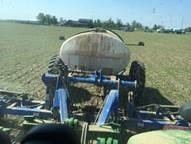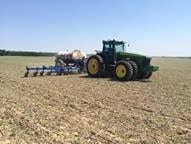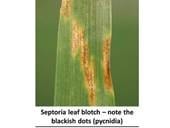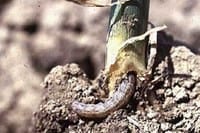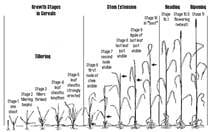Good afternoon,
Today we side-dressed nitrogen to the Corn Response to Nitrogen on-farm research plot. There were six treatments of nitrogen replicated three times in the field. The different treatments were 0 lbs N, 50 lbs N, 100 lbs N, 150 lbs N, 200 lbs N, and 250 lbs N. The corn was in V2 growth stage and also had 28 lbs N starter fertilizer applied at planting. The location of the plot is on the northeast corner of County Road 60 and County Road 135. Thanks to cooperating farmer Jerry McBride for agreeing to do this OSU Extension county research plot as a way to provide local data for updating the Tri-State Fertilizer Recommendations which will occur in the future. I’ve included a few photos from today.
The Hardin County OSU Alumni Club will be having its Annual Banquet on June 4 at St. John’s United Church of Christ in Kenton. The banquet will begin at 6:30 pm and will feature Hardin County’s own Dr. Bruce McPheron, Ohio State University Vice President and Dean of the College of Food, Agricultural and Environmental Sciences as the guest speaker. If you are interested in attending this event, contact club president Bob Simmons as soon as possible at 419-634-9510 (bsimmons@wcoil.com) for tickets and further information. Tickets for the banquet are $20 per person.
Do you have children or grandchildren between the ages of Kindergarten through 5th grade who might have an interest in gardening? The Hardin County Master Gardener Volunteers are sponsoring the annual Children’s Day at the Friendship Gardens. This event will be held Saturday, June 13 from 10:00 am – 12:30 pm. The theme this year is Bugs, Birds, and Bees! Oh My! This year’s event will feature a live bald eagle brought in by the Black Swamp Raptors. See the attached news article and flyer for more details as well as information about how to register by June 1. This event is a well-planned educational program with crafts and refreshments, so make sure you spread the word and get your youngsters there. Parents and grandparents are allowed to participate as well!
Children’s Day at the Friendship Gardens News Release
The Ohio Soybean Association (OSA) and USDA’s Risk Management Agency (RMA) is reminding Ohio farmers that they need to have their Highly Erodible Conservation and Wetland Conservation Certification for (AD-1026) on file with their local USDA service center by June 1, 2015. This requirement was created in the 2014 Farm Bill and farmers must file the form by the deadline in order to become or remain eligible for crop insurance premium support. For more information, go to http://www.soyohio.org/association/deadline-approaching-for-crop-insurance-premium-support-eligibility/.
I have also attached an article about summer grain storage from North Dakota State University Extension. This article includes information about how to keep the grain cool and dry to prevent damage as well as insect infestations. I hope you are nearing completion of planting crops if you are not already done. Make sure you set aside time to spend with family and remember the veterans who gave the ultimate sacrifice this Memorial Day weekend. I have included some agronomy article below if you are interested and have time to read them.
Keep Stored Grain Cool and Dry
Mark
Early-May Wheat Disease Update – Pierce Paul, Jorge David Salgado
The wheat crop in Ohio is now at or just past Feekes 8 (flag leaf emergence), the growth stage at which we usually recommend fungicide application for foliar disease control. However, conditions have been fairly hot and dry over the last 7 to 10 days, slowing down the development of early-season diseases such as powdery mildew and Septoria. Septoria tritici leaf spot usually shows up first on the lower leaves as yellowish flecks that later develop into irregularly-shaped, brownish-gray lesions, with dark-brown to black spots in the center. The disease is usually spread from the lower to the upper leaves by rain splash; so, unless it rains and becomes cool (50 to 68oC) over the next week or so, Septoria leaf spot may not become a problem this year. Go to http://corn.osu.edu/newsletters/2015/2015-12/early-may-wheat-disease-update to finish reading about early wheat diseases.
Weather Update – Jim Noel
After some early week rain of less than 0.25 inches in most places with isolated totals to 0.50 inches in the far north and west part of the state, it will turn more seasonable in terms of temperatures but very little additional rainfall is forecast during the upcoming week. It looks like the second half of May will be warmer than normal by several degrees with increasing chances for rain. However, most places will see 1-2 inches of rain which is still normal to a bit below normal. Therefore, overall, May will go down as a warmer and slightly drier than normal month. Looking ahead to summer, this appears to be an El Nino summer. The weak El Nino will continue and may strengthen some. El Nino will likely last into fall and possibly into 2016. Typically, El Nino years push crop yields closer to trend line and summer weather can have stresses from temperature and precipitation swings. http://www.cpc.ncep.noaa.gov/products/CFSv2/imagesInd3/nino34Mon.gif
Early Insect and Slug Concerns – Andy Michel
For a couple of weeks we have been warning about the possibility of black cutworms based on adult catches reported by surrounding states. We have begun to observe some minor feeding on corn, suggesting that the larvae are there and the worst of the damage is yet to come. We have also received some reports of slug feeding—this is no surprise given the amount of early season rain as well as the more recent precipitation over the weekend. As our crops are starting to emerge, these are prime sources of food for hungry cutworms and slugs. Now is the time to scout your fields for the presence of damage from these pests. Go to http://corn.osu.edu/newsletters/2015/2015-12-1/early-insect-and-slug-concerns to continue reading this article.
How is that stand? – Anne Dorrance
Some soybeans have been planted and issues have already been reported. The most common symptom is spotty areas around the field with large skips or limited emergence. Take a garden trowel and dig up a few places and try to find the seed that was placed there. Here is a review of the seedling disease issues that are common most years in Ohio. The Watermolds, Pythium and Phytophthora, are very common on poorly drained, high clay soils. These pathogens love wet soil conditions. The few places in the state where saturated soil conditions have occurred are the very typical. Look for any shade of brown or tan on the seedling root or hypocotyl, the area right behind the deep green cotyledon. Go to http://corn.osu.edu/newsletters/2015/2015-12-1/how-is-that-stand to continue reading about early disease problems in soybeans.
Identifying Feekes Growth Stages 9 and 10 – Pierce Paul, Karasi Mills, Laura Lindsey
Feekes growth stages 9 (full flag leaf emergence) and 10 (boot stage) can be identified without having to pull plants from the field. At this stage, you are no longer looking for and counting nodes at the base of the stem. Once the wheat crop is beyond Feekes growth stage 8 (flag leaf emergence), you can simply observe tillers in the field to determine if the flag leaf is fully emerged (Feekes 9) or if the wheat spikes (aka the head) is swollen in the leaf sheath of the flag leaf (Feekes 10; commonly referred to the boot stage). Go to http://corn.osu.edu/newsletters/2015/2015-12/identifying-feekes-growth-stages-9-and-10 for the different steps to identifying Feekes growth stages 9 and 10 in wheat.
Mark A. Badertscher
Agriculture and Natural Resources Educator
OSU Extension Hardin County
1021 W. Lima Street, Suite 103, Kenton, OH 43326
419-674-2297 Office

